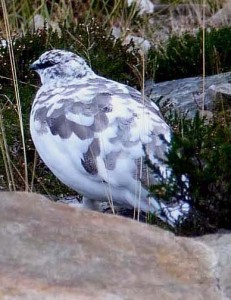 The first snow on the hills and at lower levels, plus the frosts and ice, have heralded the winter and wildlife across the board has to prepare for a lengthy spell of similar weather. For wildlife on the high tops there may well be snow around until next spring and you can get an idea of the extent of this snow by looking at Ben Wyvis that can be seen from many vantage points in and around Inverness. Two species, the mountain hare and ptarmigan have their own ways of coping with the threat of predators such a golden eagles. They change their general colour to white and they are then camouflaged against the snow as long as they stay still.
The first snow on the hills and at lower levels, plus the frosts and ice, have heralded the winter and wildlife across the board has to prepare for a lengthy spell of similar weather. For wildlife on the high tops there may well be snow around until next spring and you can get an idea of the extent of this snow by looking at Ben Wyvis that can be seen from many vantage points in and around Inverness. Two species, the mountain hare and ptarmigan have their own ways of coping with the threat of predators such a golden eagles. They change their general colour to white and they are then camouflaged against the snow as long as they stay still.
The ptarmigan is rather smaller than a red grouse and in winter it completely changes its feathers to white all over except for the tail and the eye patch which remains black all the year round. They rarely live below 700 metres where there is little vegetation, scattered boulders and bare rock. In the summer this affords the mainly barred grey, brown and black feather excellent camouflage. When the snow comes it uses its feathered feet to dig through the snow for food that includes plant shoots, leaves, and seeds, including heather, bilberry and crowberry. The young eat insects and these are crucial for the early stages of development, especially the chicks. There are estimated to be around 10,000 pairs in Scotland but this is only a guide as they are very difficult to survey. They are still on the quarry list within the legal season although many people believe that the numbers are so low and populations so isolated that shooting should be stopped altogether.
Although red deer will go to the high tops, the only true mammal that lives in such extreme weather conditions is the mountain hare. In recent years there has been an ongoing controversy over allegations that many estates have been shooting excessive numbers of these hares. The distribution of the mountain hare, sometimes called the “blue” hare, “varying” hare or “arctic” hare is confusing. This is because of the many introductions to areas mainly for sport. The mountain hare moults no less than three times each year, going from brown to grey brown from early to late summer, brown to white in the autumn to mid-winter and white to brown again in late winter to early summer. The rate of moulting depends on the altitude and temperature and some hares, particularly late season young, called leverets, do not go completely white. Intriguingly some completely black mountain hares were found in south east Caithness some years ago and it is still not clear whether there are any still there.
Apart from man the main predator is the fox but wildcats and golden eagles will take the adults and the leverets are taken by buzzards and stoats. There appears to be a link between larger numbers of mountain hares in north-east Scotland and the ability for golden eagles to bring off two chicks per year. Eagles start to incubate their eggs as the first one is laid so one chick is stronger than the other. If there is sufficient food, such as plenty of mountain hares, then both chicks will survive, but if there is a shortage the older more robust chick will take all the food and will even eat the smaller sibling! In the white winter coat the mountain hare is well camouflaged from predators when there is snow around but they, as with the ptarmigan, still have the enemy of the weather to cope with.
